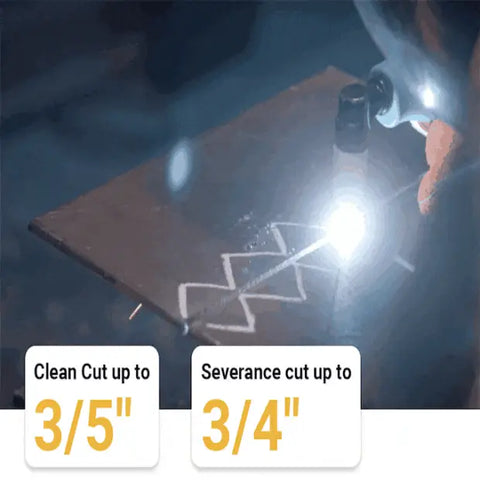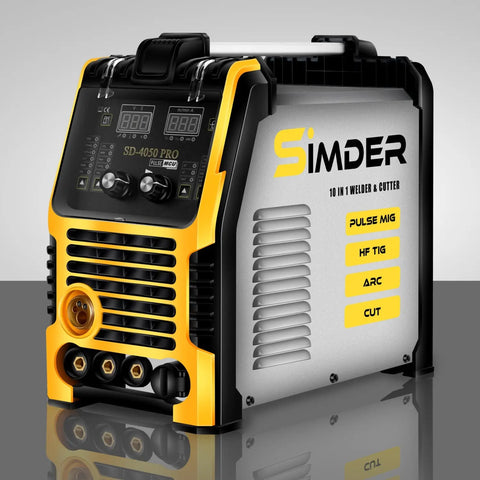A Comparison of Different Types of Welding Machines
Oct 04, 2023
A Comparison of Different Types of Welding Machines: MIG, TIG, Arc Welders and Plasma Cutters
The field of welding technology has made advancements and today there are various types of welding machines available, in the market. It's crucial to understand the distinctions between these machines to select the one for your specific requirements. Each machine has its applications and advantages that make it suitable for different welding and cutting tasks.
MIG Welders
MIG (Metal Inert Gas) welding machines are widely used in both DIY and professional settings due to their versatility. These machines utilize a wire electrode to generate an arc that melts and merges metal materials together. Here are some key features of MIG welders:
Pulse MIG Welding: Many MIG welders come with pulse MIG welding capabilities which are particularly useful for situations where heat control is challenging. This feature ensures improved weld quality and appearance.

Aluminum Welding: With control over the welding process MIG welders are capable of effectively welding aluminum. The inclusion of a setup with a Graphene Conduit Liner makes aluminum welding accessible without requiring a spool gun.
Gas Options: Users have the option to select from gases, such, as CO₂ or mixed gas which gives them flexibility for welding projects. This flexibility ensures control over the force and speed of the arc strike.
Flux Core Welding: MIG welders are also capable of performing flux core welding, which makes them suitable for projects in windy conditions. This feature is particularly useful when working with materials like steel and carbon steel.
Synergic MIG: The synergic mode simplifies welding by adjusting the welding parameters based on the wire feeding speed. This user friendly feature is suitable for welders of all skill levels.

TIG Welders
Tungsten Inert Gas (TIG) welding machines are renowned for their precision and ability to create high-quality welds. They are popularly used in applications where aesthetics and control are crucial. Here are some notable features of TIG welders:
High Frequency Start TIG Welding: TIG welders offer a high frequency start TIG mode that enables welders to tackle joints and create seams through non-contact ignition. This feature proves beneficial when dealing with angles.

Versatility: TIG welders can effectively work with metals, including steel, alloy steel, carbon steel and non-ferrous metals. They are well suited for handling workpieces as well as using welding rods like 7018, 6013 and 6010.
Portability: Numerous TIG welding machines are designed to be lightweight and portable making them incredibly handy for both personal and commercial use.
Hot Start and Arc Force: These remarkable functionalities enhance the dependability of arc striking. Minimize spatter during welding resulting in a more enjoyable welding experience.
ARC & Lift TIG 2 in 1: Certain TIG welders offer versatility by functioning as both ARC MMA stick welders and Lift TIG welders. This flexibility caters to a range of welding tasks.
Arc Welders
Arc welding machines, commonly referred to as stick welders are renowned for their simplicity and durability. They excel at heavy-duty welding applications often finding application in construction and repair work. The following are features associated with arc welders:
Stick Welding: Arc welders excel at stick welding with electrodes such as 6018, 7013, 6011 and 6010. They can effortlessly handle materials up to 5/16 inches

Dual Voltage Capability: Many arc welders are equipped with dual voltage capabilities allowing users the convenience of switching between 110v and 220v power sources.
Display: Some modern arc welders incorporate screens that provide suggested dimensions for welding rods while automatically adjusting the current. This feature simplifies operation processes.
Plasma Cutter
When it comes to welding and metalworking it's essential to select the equipment to achieve the desired outcomes for your projects. Let's take a look at plasma cutters, which are specifically designed for metal cutting. They use a high-velocity stream of ionized gas to melt and sever metals. Here are some key features of plasma cutters:
Efficient Cutting: Plasma cutters can effectively slice through metals like steel, stainless steel, alloy steel, mild steel, copper and aluminum. They can make cuts up to 1/4 inch thick and severance cuts up to 1/2 inch thick.

Dual Voltage Capability: Certain plasma cutters offer the convenience of dual voltage options, making them suitable for tasks due to their nature.
Safety Measures: Plasma cutters often come equipped with safety features such as overheating protection and current display systems that ensure efficient cutting operations.
Professional Grade Performance: These machines are specifically designed for use in industries that require precision cutting, such as manufacturing, construction and metal fabrication.
Comparative Summary
Selecting the equipment is paramount when it comes to welding and metalworking projects. Plasma cutters provide the precision needed for results, in this field.
Let's explore the summary of MIG welders, TIG welders, Arc welders and plasma cutters, in detail. This will help you make an informed decision based on your welding and cutting requirements.
|
Aspect |
MIG Welders |
TIG Welders |
Arc Welders |
Plasma Cutters |
|
Versatility |
Versatile and adaptable to various applications. |
Precision machines ideal for specialized welds. |
Rugged and straightforward for heavy-duty tasks. |
Designed primarily for precision cutting. |
|
Ease of Use |
Offers ease of use and is suitable for beginners. |
Requires a higher skill level but provides precision. |
Generally user-friendly, making it accessible for all levels. |
More straightforward in operation for cutting applications. |
|
Quality of Welds/Cuts |
Capable of producing strong and aesthetically pleasing welds. |
Known for creating high-quality and visually appealing welds. |
Reliable for robust welds but may lack finesse in aesthetics. |
Ensures clean and efficient metal cuts. |
|
Applications |
Widely used in various industries and DIY projects. |
Preferred for applications where aesthetics are critical. |
Ideal for heavy-duty welding tasks and outdoor use. |
Commonly used in industries requiring precision cutting. |
|
Materials |
Suitable for welding a wide range of materials. |
Versatile and compatible with various metals. |
Suitable for various electrodes and thick materials. |
Primarily for cutting metals, including steel and alloys. |
|
Portability |
Available in portable and compact designs. |
Lightweight and portable models are available. |
Varies in size and portability; some are lightweight. |
Portable options for ease of movement. |
|
Skill Level |
Beginner-friendly; suitable for novice welders. |
Requires a higher skill level; more suitable for experts. |
Accessible to welders of all levels, including beginners. |
Generally straightforward, easy for operators. |
SSimder SD-4050 Pro 10-in-1 Aluminum Welder and Cutter Machine, 10-in-1 means one welder 10 function, it can achieve almost all the functions mentioned above, Multifunction and Lightweight, take your welding skill to the next level.
When it comes to choosing between MIG, TIG Arc welders or plasma cutters, your decision ultimately depends on your welding and cutting needs. Take into account factors such, as the materials you work with, the desired quality of welds or cuts, your skill level and the level of portability needed for your projects. By evaluating these aspects you can choose and select the appropriate welding or cutting machine that will yield optimal results for your metalworking endeavors.



